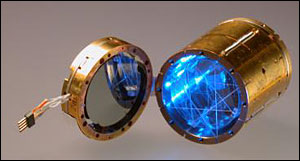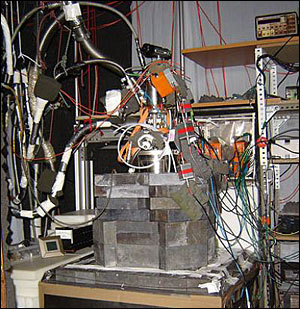
Dark Matter Detector Devised
A scintillating bolometer containing a crystal comprised of bismuth, germinate and oxygen (BGO) has been developed to detect the dark matter of the universe.
Researchers from the University of Zaragoza in Spain and France's Institut d'Astrophysique Spatiale (IAS) developed the bolometer, which has been tested at the Canfranc Underground Laboratory in Huesca, Spain. To work properly, the device has to be kept supercold, at temperatures near absolute zero (-273.15 °C), and housed under tons of rock in an underground lab.

The BGO scintillator crystal (right) and germanium disc (left). (Images: IAS / SINC)
"One of the biggest challenges in physics today is to discover the true nature of dark matter, which cannot be directly observed - even though it seems to make up one-quarter of the matter of the universe," Eduardo García Abancéns, a researcher from the University of Zaragoza's Laboratory of Nuclear Physics and Astroparticles, told the Spanish news service SINC. "So we have to attempt to detect it using prototypes such as the one we have developed."
Direct and indirect detection methods are used to detect dark matter, which cannot be directly observed since it does not emit radiation. The former include simultaneous light and heat detection (such as the technique used by scintillating bolometers), simultaneous heat and ionization detection, and simultaneous light and ionization detection, such as research into distinctive signals (the most famous being the search for an annual modulation in the dark matter signal caused by the orbiting of Earth).
There are also indirect detection methods, where, instead of directly seeking the dark matter particles, researchers try to identify other particles, (neutrinos, photons, etc.), produced when the universe's dark matter particles are destroyed.
García Abancéns is one of the scientists working on the ROSEBUD project (an acronym for Rare Objects Search with Bolometers Underground), an international collaborative initiative between IAS (CNRS-University of Paris-South) and the University of Zaragoza, which is focusing on hunting for dark matter in the Milky Way.
The scientists have been working for the past decade on this mission at the Canfranc Underground Lab, where they have developed various cryogenic detectors (which operate at temperatures close to absolute zero: -273.15 °C). The latest is a scintillating bolometer, a 46-g device that, in this case, contains a crystal "scintillator" comprised of bismuth, germinate and oxygen, which acts as a dark matter detector.
"This detection technique is based on the simultaneous measurement of the light and heat produced by the interaction between the detector and the hypothetical WIMPs (Weakly Interacting Massive Particles) which, according to various theoretical models, explain the existence of dark matter," García Abancéns said.

The experimental arrangement in the underground laboratory at Canfranc.
The difference in the scintillation of the various particles enables this method to differentiate between the signals that the WIMPs would produce and others produced by various elements of background radiation (such as alpha, beta or gamma particles), he said.
In order to measure the miniscule amount of heat produced, the detector must be cooled to temperatures close to absolute zero, and a cryogenic facility, reinforced with lead and polyethylene bricks and protected from cosmic radiation as it housed under the Tobazo mountain, has been installed at the Canfranc underground laboratory.
"The new scintillating bolometer has performed excellently, proving its viability as a detector in experiments to look for dark matter, and also as a gamma spectrometer (a device that measures this type of radiation) to monitor background radiation in these experiments," said García Abancéns.
The scintillating bolometer is currently at the Orsay University Centre in France, where the team is working to optimize its light gathering, and carrying out trials with other BGO crystals.
The research was published recently in the journal Optical Materials.
For more information, visit: /www.fecyt.es/fecyt/home.do
Published: September 2009